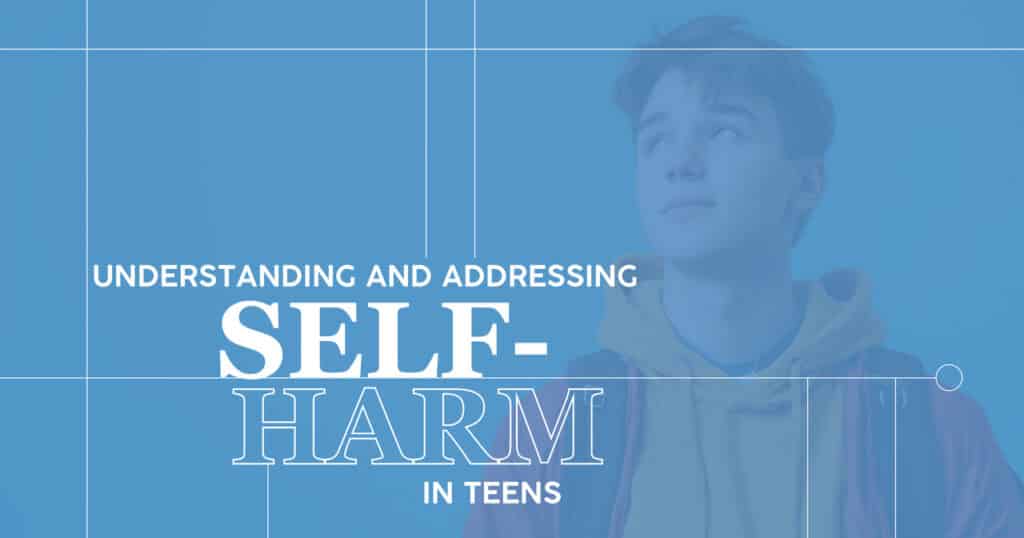Understanding Self-Harm in Teens
Understanding and addressing self-harm in teens is a critical issue that affects countless young people and their families. Self-harm is a complex behavior that encompasses various forms of self-injurious behavior, such as skin cutting or burning, and is often misunderstood. Addressing it requires a compassionate, informed approach.
Essential Takeaways
- Recognize the Signs Early: Spotting physical, behavioral, and emotional indicators of self-harm early allows for timely intervention and support. This includes noticing patterns of blood stains or unexplained injuries that may indicate harm in teenagers.
- Promote Open Communication: Foster a trusting relationship with your teen through empathetic, open dialogue to better understand and support their struggles. A school counselor or mental health provider can facilitate this communication.
- Seek Professional Help: Professional therapy and counseling are crucial for managing self-harm and addressing underlying mental health conditions. Creating a supportive environment and encouraging healthy coping strategies for effective recovery is vital.
In this blog post, we’ll dive deep into what self-harm is, how to recognize it, its causes, and how to support teens who are struggling effectively.
Understanding Self-Harm in Teens
Self-harm refers to the act of deliberately inflicting physical harm on oneself as a way to cope with emotional pain, stress, or distress. It can take various forms, including cutting, burning, or hitting oneself. Importantly, self-harm is not necessarily an indicator of suicidal intent, although it does require serious attention and intervention.
For many teens, self-harm serves as a way to express feelings of distress that are difficult to verbalize or to gain a sense of control over their internal turmoil. Understanding this behavior within the context of a teen’s emotional landscape is crucial for providing adequate support.
Why Teens Self-Harm
The reasons behind self-harm are as diverse as the teens who engage in it. Here are some common factors:
Emotional Distress
Teens often use self-harm as a way to manage overwhelming emotions like sadness, anger, or frustration. It can provide a temporary sense of relief from emotional pain and serves as an unhealthy coping mechanism.
Coping Mechanism
For some, self-harm becomes a coping mechanism when other methods of dealing with stress or emotional challenges seem insufficient or unavailable. This can include compulsive behavior or engaging in risky behaviors.
Underlying Mental Health Issues
Conditions like depression, anxiety, and borderline personality disorder are often linked with self-harming behaviors. Self-harm can sometimes be a manifestation of deeper psychological struggles and can signal mental health concerns.
Recognizing the Signs
Identifying self-harm can be challenging, especially if a teen is hiding their behavior. However, there are several signs that parents and caregivers can watch for:
Physical Indicators
- Unexplained Cuts or Bruises: Look for frequent, unexplained injuries, especially if they are in patterns or on areas of the body that are usually covered.
- Wearing Long Sleeves in Hot Weather: Teens may cover up injuries by wearing long sleeves or pants, even in hot weather.
- Burns or Scars: Noticeable burns or old scars can be indicators of self-harm, especially if they are in unusual locations. Skin with needles may indicate a more severe form of self-injury.
Behavioral Changes
- Withdrawal: A teen who suddenly becomes more withdrawn or isolates themselves from family and friends may be struggling with self-harm.
- Secrecy: Increased secrecy about their whereabouts or activities can be a red flag. Teens might go to great lengths to hide their behavior.
- Mood Swings: Rapid or severe mood swings, including irritability or emotional instability, can accompany self-harming behaviors.
Emotional Symptoms
- Feelings of Worthlessness: Self-harm is often associated with feelings of low self-esteem or self-loathing. Teens might express or show signs of feeling worthless or undeserving of care.
- Increased Anxiety or Depression: Teens engaged in self-harm may exhibit heightened levels of anxiety or depression. They might also have trouble managing daily stressors and painful emotions.
Understanding the Root Causes
Understanding why a teen might engage in self-harm involves looking at a range of factors, from emotional struggles to environmental influences.
Emotional and Psychological Factors
- Trauma: Past traumatic experiences, such as abuse or significant loss, can contribute to self-harming behavior. Trauma often leaves deep emotional scars that self-harm attempts to manage.
- Depression and Anxiety: Teens with depression or anxiety may use self-harm as a way to cope with their intense emotions. It can sometimes provide a temporary distraction from their psychological pain.
- Low Self-Esteem: Teens who struggle with self-worth or feel inadequate might self-harm as a way to externalize their internal negative feelings.
Environmental and Social Influences
- Bullying: Experiencing bullying or harassment can increase the risk of self-harm. The constant emotional strain can make self-harm seem like a viable way to cope.
- Family Issues: Dysfunctional family dynamics, such as high levels of conflict or lack of emotional support, can exacerbate feelings of distress in teens, leading to self-harm.
- Peer Pressure: Pressure from peers, including feeling excluded or not fitting in, can also contribute to self-harming behavior as a form of escape or expression.
Genetic and Biological Considerations
- Genetics: There is some evidence to suggest that self-harm may have a genetic component. A family history of mental health disorders can increase susceptibility.
- Neurobiological Factors: Imbalances in brain chemicals or neurobiological dysfunctions might contribute to self-harm behaviors, although this area of research is still developing.
Addressing Self-Harm
Addressing self-harm involves a multi-faceted approach that includes open communication, seeking professional help, and creating a supportive environment.
Open Communication
Talking to Your Teen:
- Approach with Empathy: When discussing self-harm, approach the conversation with empathy and understanding. Avoid being judgmental or critical, as this can further isolate the teen.
- Listen Actively: Allow your teen to express their feelings without interruption. Show that you are genuinely interested in their well-being and willing to listen.
- Provide Reassurance: Reassure them they are not alone and that seeking help is a positive step. Let them know that their feelings are valid and that there are ways to cope.
Seeking Professional Help
Consulting Mental Health Professionals:
- Therapy: Professional counseling or therapy can be highly effective. Cognitive Behavioral Therapy (CBT) and Dialectical Behavior Therapy (DBT) are commonly used approaches to help teens manage self-harm and underlying issues.
- Medication: In some cases, medication may be prescribed to address underlying mental health conditions, such as depression or anxiety. A healthcare provider should manage this.
- Family Therapy: Involving the whole family in therapy can help address underlying family dynamics and improve communication and support systems.
Creating a Supportive Environment
Building a Safe Space:
- Create Open Dialogue: Foster an environment where your teen feels safe discussing their feelings. Encourage regular check-ins and open conversations about their emotional state.
- Promote Healthy Coping Mechanisms: Help your teen find alternative ways to cope with stress, such as engaging in hobbies, practicing mindfulness, or participating in physical activities.
- Support and Understanding: Show ongoing support and understanding. Celebrate small victories and progress, and be patient as your teen works through their challenges.
Treatment and Support
Effective treatment and support are essential for helping teens overcome self-harm and improve their overall mental health.
Therapy and Counseling
Types of Therapy:
- Cognitive Behavioral Therapy (CBT): Focuses on changing negative thought patterns and behaviors. It helps teens develop healthier ways of thinking and coping with stress.
- Dialectical Behavior Therapy (DBT): Combines cognitive-behavioral techniques with mindfulness and emotional regulation strategies. It is particularly effective for teens with emotional dysregulation.
Medication and Medical Interventions
When Medication is Necessary:
- Antidepressants: In cases where depression or anxiety is a significant factor, antidepressant medication may be prescribed to help manage symptoms.
- Regular Monitoring: A healthcare provider should monitor medication closely to assess its effectiveness and make any necessary adjustments.
Building Coping Skills
Developing Healthy Coping Strategies:
- Mindfulness and Relaxation: Techniques such as mindfulness meditation and relaxation exercises can help teens manage stress and reduce the urge to self-harm.
- Engagement in Activities: Encouraging participation in enjoyable activities, such as sports, art, or social events, can provide a positive outlet for emotions and reduce the focus on self-harm.
Prevention and Long-Term Support
Prevention and ongoing support are crucial for maintaining progress and promoting long-term mental well-being.
Educating and Raising Awareness
Awareness and Education:
- Informing Family and Friends: Educate family members and friends about self-harm to foster a supportive network and reduce stigma.
- Community Resources: Utilize community resources and support groups to connect with others who understand the challenges of self-harm and mental health issues.
Building Resilience and Emotional Regulation
Fostering Resilience:
- Resilience Training: Help your teen build resilience by teaching problem-solving skills, emotional regulation, and positive self-talk.
- Encourage Positive Relationships: Support your teen in developing positive, healthy relationships with peers and adults.
Monitoring and Follow-Up
Ongoing Support:
- Regular Check-Ins: Continue regular check-ins with mental health professionals to monitor progress and adjust treatment as needed.
- Support Systems: Maintain and strengthen support systems to ensure your teen can access ongoing emotional support and resources.
Conclusion
Understanding and addressing self-harm in teens is an essential part of supporting their mental health and overall well-being. By recognizing the signs, understanding the causes, and implementing effective strategies for support and treatment, families can make a significant difference in their teen’s recovery journey.
Call to Action
If you or someone you know is struggling with self-harm, don’t wait to seek help. Contact a mental health professional to explore treatment options and support systems.
For more resources and information on supporting teens with self-harm, visit our website and connect with our community of experts. Take proactive steps today to positively impact your teen’s mental health and future.
FAQs
- What are some signs that a teen might be self-harming? Look for unexplained injuries, wearing long sleeves in hot weather, withdrawal from social activities, and sudden mood changes.
- How should I talk to my teen about self-harm? Approach the conversation with empathy and understanding. Listen actively, provide reassurance, and avoid judgment.
- What types of therapy are effective for treating self-harm? Cognitive Behavioral Therapy (CBT) and Dialectical Behavior Therapy (DBT) are commonly used to help manage self-harm and underlying issues.
- How can I help my teen develop healthier coping mechanisms? Encourage participation in enjoyable activities, teach mindfulness and relaxation techniques, and promote open communication.
- Where can I find more resources for supporting teens with self-harm? For additional resources and information, visit mental health services, consult with healthcare professionals, and connect with support groups.




